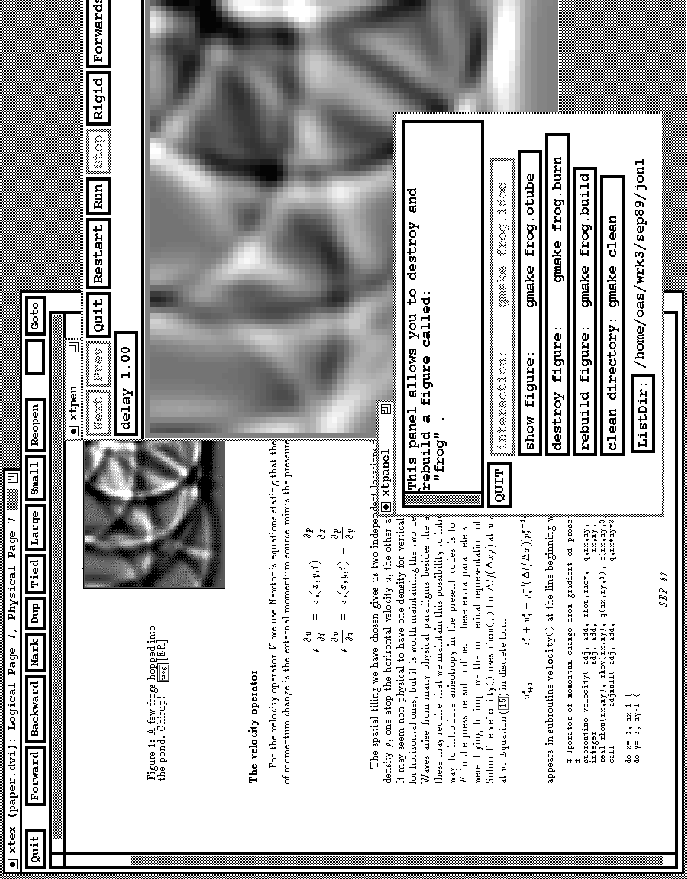




Next: ACKNOWLEDGMENTS
Up: OUR LABORATORY'S REDOC RULES
Previous: Tube
A community's cleaning rule is designed to remove the intermediate
files and thereby to isolate the source and result files. A universal
cleaning rule attempts to recognize the intermediate files according
to the community's naming conventions. Unfortunately, such a
rule cannot possibly anticipate all names the
author may choose for his intermediate files. Consequently, our
laboratory does not supply a fixed, universal clean rule, but a
jclean (Jon's clean) rule. jclean removes the files
that adhere to our laboratory's naming convention for intermediate
files. Every author is responsible to implement his own clean
rule. Most authors at our laboratory accept the default cleaning rule
by defining clean as:
clean: jclean
Some authors at our laboratory
append the default jclean with a command to remove
some additional files that do not adhere to the standard naming
conventions. Only very few authors ignore the jclean target (and
its communal wisdom) and design their own rule.
Since the author of the Frog example adheres strictly to the
ReDoc naming conventions for files, the default jclean mechanism
suffices to remove the intermediate files:
jclean : klean.usual klean.fort ;
KLEANUSUAL := core a.out paper.log *.o *.x *.H *.ps *.gif
klean.usual :
@-${TOUCH} ${KLEANUSUAL} junk.quiet
@-${RM} ${KLEANUSUAL} junk.*
FORT_FILES = $(patsubst %.f,%,$(wildcard *.f)) junk.quiet
klean.fort:
@\
for name in ${FORT_FILES} ; do \
if ${EXIST} $${name}.r ; then \
${TOUCH} $${name}.f ; \
${RM} $${name}.f ; \
fi ; \
done
The jclean target uses two methods to identify intermediate
files. The first method, klean.usual, simply removes files whose
names fit one of the rule's name patterns: e.g. the executable
frog.x, or the intermediate bitmap files junk.pgm and
junk.ppm. The second method, klean.fort, removes FORTRAN files, such as frog.f, if RATFOR versions of the program, such
as frog.r, exist.
xtpanel
Figure 3
The reader interface for reproducible research is only one
component of SEP's current computational research environment: A
research document at SEP is written in LATEX(visible in the
background to the left). Using SEP's own LATEX macros, a
push-button in each figure caption invokes a graphic user interface
(written in a script language called xtpanel). The graphic user
interface enables a reader to interactively execute the burn,
build, clean, and tube commands for each individual figure. (The
panel is shown in the foreground. The result of make tube is
shown towards the right.) SEP's GNU make rules allow an author to
easily extend the interactivity of a result figure to additional,
application-specific actions. Unfortunately these features are beyond
the scope of this article. However, we distribute our collection of
software and the theses of our research group on CD-ROMs.

We are currently collaborating with Richard Stallman of the Free Software
Foundation to develop an alternative, more reliable cleaning
mechanism. This alternative mechanism would free the author
from naming the intermediate files according to the community's naming
conventions. The anticipated cleaning mechanism analyses the
makefile's rules and dependencies to identify the intermediate files.
Fastidious authors would have the option of automatically removing all
files that are neither source files nor result files.





Next: ACKNOWLEDGMENTS
Up: OUR LABORATORY'S REDOC RULES
Previous: Tube
Stanford Exploration Project
11/12/1997
